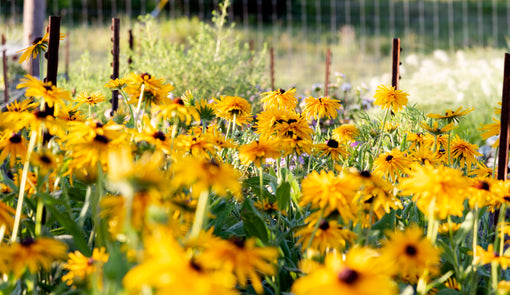
- Article published at:
- Article author: Robin Blood
- Article comments count: 0
Drawer menu
No matter how well prepared you are as a gardener, nature will always serve up unpleasant and unforeseen surprises at the worst times. Since I began my journey as a flower farmer in north Texas in spring 2020, I have experienced at least one hard freeze event subsequent to planting out my crop of seedlings in late-March, early-April.
These late-season hard freezes are never something a grower looks forward to and can be extremely stressful times due to the fragility seedlings have to harsh temperatures at this young stage of their growth. Protecting your garden or farm from a hard freeze can be a challenging task, but with the right preparation and techniques, it is possible to keep your plants safe and healthy.
Below, I will outline 6 strategies that can be used to safeguard your plants in the likely event of an unseasonably late freeze.
1. Cover your plants
Covering your plants can be accomplished in a variety of ways. There are many products available on the market ranging from light frost cloths that can be draped over foliage (give about 4 degrees protection), to heavy duty, multi-layered plastic tarps that require structures like PVC hoop tunnels to create an air-insulated buffer between the plants and the freezing air. For hard freeze events, I would recommend building these types of structures and using the heavy plastic tarps. While these are superior to the lighter frost cloths, it is important to remember that the tarp should not be making direct contact with any foliage of the plants. Any contact will freeze the moisture directly on the foliage causing "leaf-burn" and can irreparably damage the plant. For larger, individual potted plants, an effective structural material are "tomato-cages". These metal structures surround the plant and will keep the plastic tarps from touching any foliage.
2. Water your plants
Watering your plants well just before AND after a hard freeze is a terrific method for protecting your plants from damage. I would suggest root watering your plants the day prior to a hard freeze. This will help to insulate the roots by creating a more stable and consistent soil temperature. Do not water so thoroughly as to create puddles of standing water around the plants, but do water enough to completely saturate the soil there-in creating the insulating effect. Watering roots & foliage directly after day-time temperatures restore to above freezing will help keep the roots at this stable temperature, lessen leaf burn from frost and will also protect against any additional dips below freezing that may happen in the proceeding cold nights. The key to remember here is that we are trying to simulate a stable climate for the root systems of plants. The roots are a major control center for plant health and should be prioritized in protecting for the long-term health of the plant.
3. Use mulch
Mulch is yet another effective way to insulate the soil and protect your plants' roots. A layer of mulch covering the roots will have small air gaps in between each fragment of the woody material which can operate similarly to the plastic tarp protecting the foliage. The mulch itself will also act as an insulating layer that will help keep warmth from the ground from escaping and getting pulled from the plant by the freezing air. To accomplish this technique, spread a 1"-3" layer of mulch around the base of your plants. Ensure there is a consistent coverage and none of the plant base is visible.

4. Move potted plants indoors
This one may seem obvious, but if you have potted plants, it's best to move them indoors during a hard freeze. Plants that are in pots do not share nearly the same advantage as those planted in the much more thermally stable ground. It is much easier for potted plants to become damaged in freezing temperatures and may not be able to recover as adequately. As an additional tip, it may be helpful to purchase a small dolly to transport heavy potted plants in and out of the house or garage.
5. Use heat lamps or heating cables
If you have a small area or specific plants that you want to protect, you can use heat lamps or heating cables to keep them warm. The benefit of using heating sources to keep your plants protected is that it is much more comforting to know that they will not be exposed to any extreme temperatures throughout the hard freeze event. On the contrary, if you do have a well insulated area to keep heated, it can be quite cost inefficient to sustain a warm average temperature. I have experienced large increases in my utility bill during rapid freezing events. It should also be noted that there is always a chance that heater fails or a fire occurs due to a malfunction with the heating equipment. In both of these cases, significant damage can occur to both plant and property. Be sure to use these with caution and follow the manufacturer's instructions.
6. Prune your plants
Pruning your plants before a freeze can help to reduce the amount of exposed surface area that a plant has to the freezing air. This can be accomplished by removing any dead or damaged branches and leaves, as these can act as a conduit for the cold.

By following these tips, you can help to protect your garden from a hard freeze and keep your plants safe and healthy. Remember that while you can take steps to protect your garden, there is always a risk of damage or loss during a freeze. Be prepared for the worst and hope for the best.